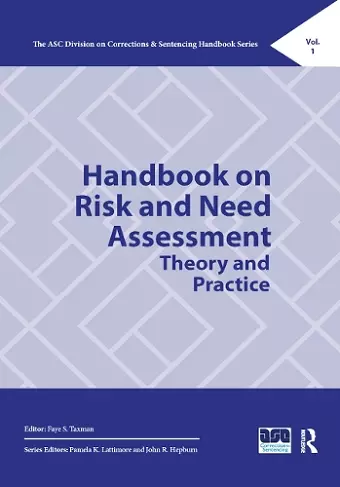Handbook on Risk and Need Assessment
Theory and Practice
Format:Paperback
Publisher:Taylor & Francis Ltd
Published:2nd Oct '19
Currently unavailable, and unfortunately no date known when it will be back
This paperback is available in another edition too:
- Hardback£220.00(9781138927766)

The Handbook on Risk and Need Assessment: Theory and Practice covers risk assessments for individuals being considered for parole or probation. Evidence-based approaches to such decisions help take the emotion and politics out of community corrections. As the United States begins to back away from ineffective, expensive policies of mass incarceration, this handbook will provide the resources needed to help ensure both public safety and the effective rehabilitation of offenders.
The ASC Division on Corrections & Sentencing Handbook Series will publish volumes on topics ranging from violence risk assessment to specialty courts for drug users, veterans, or the mentally ill. Each thematic volume focuses on a single topical issue that intersects with corrections and sentencing research.
Risk and need assessment has been one of academic criminology’s biggest achievements and biggest disappointments. Although assessment tools are ubiquitous across correctional systems, they have fundamentally failed, to date, to alter the culture of correctional practice. In this urgent new volume, the most important and influential assessment researchers take stock of the successes, failures and futures of the practice, exploring both the evolving science of risk prediction and the art of implementation. A most promising start to the new DCS Handbook Series. – Shadd Maruna,Professor of Criminology, University of Manchester, UK
Accurate assessment of offender risks and needs is the bedrock of efforts to improve public safety. This handbook provides a critical foundation for advancing science and policy by illuminating the tremendous progress in assessment that has occurred. It is a must-read for anyone seeking to create a safer and more just society. –Daniel P. Mears, Ph.D., Mark C. Stafford Professor of Criminology, Florida State University College of Criminology and Criminal Justice
At virtually every stage of the justice system, new methods are being employed that enable decision-makers to use risk to the public as a criterion for justice system control. Yet even as these methods diversify, the empirical foundation for risk assessment remains a work-in-progress. Too little is known about the practical significance of risk as a core justice construct and the corresponding operational significance of risk assessment as a technique. This collection brings together superb studies of risk in the correctional system, both as an idea and as a practice. It is a welcome new contribution to our understanding of the most important development in the current generation of tools for the justice professions: risk assessment. – Todd R. Clear, University Professor of Criminal Justice, Rutgers University-Newark
The major strength of the Handbook on Risk and Needs Assessment is that it provides researchers and practitioners with a comprehensive collection of chapters that helps chart the topic from its history to the implications for practice and policy. It is a must have for anyone working or studying in the field of corrections. – Edward Latessa, Professor and Director, University of Cincinnati
One of the most intense activities by the many agencies responsible for managing accused or convicted offenders these days is assessment of their needs and of their treatment needs, especially for addiction or mental illness, or their risk in the community, whether that be on pre-trial release rather than bail, sentencing, and parole or probation release or recommitment decisions. This volume has pulled together a rich array of chapters from the wide variety of perspectives involved in assessing risk and needs from both methodological and implementation perspectives.
– Alfred Blumstein, J. Erik Jonsson University Professor Emeritus, Heinz College, Carnegie Mellon University
ISBN: 9780367405175
Dimensions: unknown
Weight: 852g
492 pages